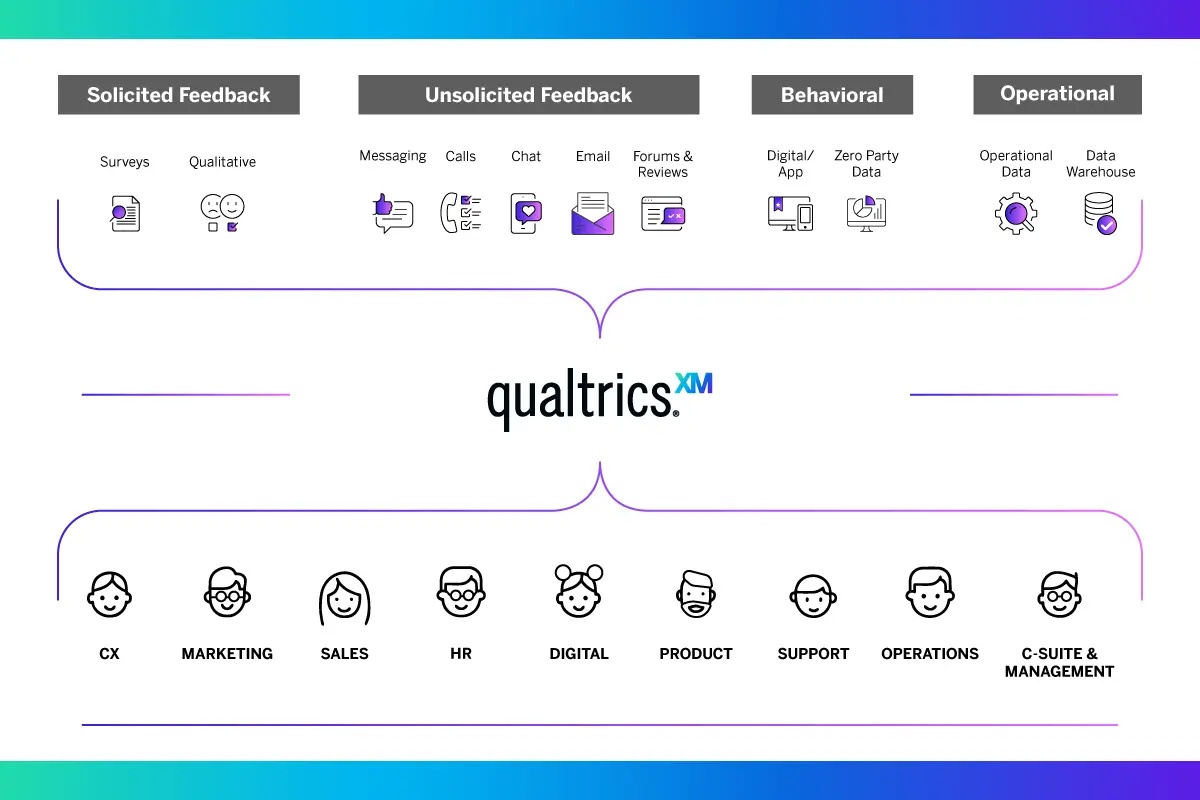What is omnichannel customer experience?
Omnichannel customer experience describes the cohesive, integrated interactions your customers have with your brand – across all touchpoints. Omnichannel CX connects physical, digital, and communication channels so people can start an interaction on one channel and continue it on another, without any disruption.
Customers no longer think of individual touchpoints as being isolated experiences. Having an incredible website doesn’t mean much if customers run into subpar experiences on associated social, marketing, or customer support channels. And great customer support can’t make up for an unusable product or website. Omnichannel means connecting the dots to make people’s journeys and experiences feel unified.
Increasingly, that also means making inter-channel journeys feel personal by leveraging customer data points to serve up experiences tailored to them.
In other words? Whenever customers are able to make seamless journeys that move from one touchpoint or platform to the next – without having to start inquiries from scratch, repeat themselves, or feel like things lack consistency – that’s omnichannel CX in action.
Benefits of an omnichannel customer experience strategy
The pros to joining up your business’s various touchpoints should be inherently obvious, but for the avoidance of any doubt: omnichannel strategies differentiate your brand from your competitors, foster customer loyalty, and boost conversion rates.
Here’s a selection of statistics to support this:
1. People already think omnichannel
- Some 73% of retail customers consider themselves omnichannel shoppers
2. Omnichannel CX should be the status quo
- 76% of customers expect consistent interactions regardless of channel
3. Omnichannel customers spend more
- Those who use more than one sales channel spend 4% more in-store, and 10% more online
4. Omnichannel customer support influences conversion
- 64% will spend more if you can resolve any issues where they already are
5. Omnichannel strategies feed customer retention
- Brands that implement unified CX processes and flows keep 89% of their customers
Customers expect omnichannel experiences
More than anything else, the key benefit of implementing an omnichannel customer experience strategy is that it’s exactly what today’s customers expect.
Did you know?
As customers compare, consider, and explore their options, a basic eCommerce transaction will include an average of 5.5 touchpoints – but this can hit up to 20.
People want brands to know who they are, understand the context of their questions, and be able to reference interaction history and buying preferences to bring them a unified, personalized experience that transcends the borders of whichever platform they’re on.
How to create an omnichannel strategy
1. Identify and break up silos
Siloed organizational structures – where departments are self-contained, with activities and budgets that stay opaque to all but the top tier of leadership – are actively unhelpful for businesses who want to adopt an omnichannel mindset. Breaking down silos is a whole topic in itself, and requires a significant degree of change to both culture and processes. But there are some relatively quick ways to begin, one being to assemble teams from across multiple departments to work on specific omnichannel projects.
For example, you may decide to capitalize on the growing popularity of branded apps to engage existing customers and assemble a team of developers, UX professionals, designers, data specialists, and customer experience experts to get the job done. With a successful project under their belt, this team can not only undertake future projects but can also play a role in internal marketing and awareness-building that will support cultural change.
2. Design for users, not channels
All marketing and communication channels must be built, developed, and optimized around maintaining a seamless sense of connection for the customer. The teams behind each channel should view their projects as part of a broader customer experience ecosystem and have an open and ongoing dialogue with each other around how channels support a typical channel-hopping user journey.
UX specialists have an important connecting role to play in the omnichannel journey, and their user testing activities need to be inclusive of all channels. They can report not only on the usability and functionality of a single feature, but on how easy it is for a user to move between channels and back again, and whether any friction or disconnect is perceived when they do so.
3. Integrate around a centralized system
The ‘omni-ness’ of an omnichannel experience is often achieved by centralizing customer data in a single place, such as a CRM or CEM system. The functional features of the system, its accessibility to internal users, and its capacity to store data from different channels all hugely influence how easy it is to provide an omnichannel experience and set one up in the first place.
A powerful CRM system means that data provided by customers can be accessed by every part of the business that needs to see it, allowing continuous, joined-up service to be provided whether the customer messages via online channels, calls you, or walks into physical stores. They have the sense of communicating with a single entity, no matter whom they speak to or how they get in touch.
Another valuable asset is a system that collects customer feedback from all points across the omnichannel customer journey and allows you to collectively process and analyze them, even if it’s provided in different formats (e.g., numerical ranking, free text in natural language, or multiple choice selection).
A unified feedback system helps you see a holistic picture of the customer experience with all channels and customer touchpoints factored in. But knowing is only part of the story – you must also be able to take action.
As well as helping you develop insights and reach conclusions about what’s happening for your customers, your omnichannel system should make it easy to determine the best course to take and empower you to make interventions quickly and decisively. This could take the form of identifying the key drivers behind certain behaviors so you can prioritize your actions, or sending alerts to the right people at the right time for prompt action.
A strong, versatile experience management system not only helps you prioritize your work when you begin building an omnichannel platform, but it also continues to deliver insights and support actions over time, enabling you to keep pace with customer expectations and industry standards as they evolve.
4. Standardize measurements
You need a common currency to successfully measure and track customers across their journeys. Unless you’re able to compare like with like, you won’t know if one part of the system is performing better or worse than another, or what language to use to set business-wide goals.
Bear in mind that some of the most useful data for improving experiences is qualitative, deriving from sources like online reviews and social media. Look for a platform that can collect and interpret experiential data in an actionable way.
5. Take a customer journey-level approach
Working on a customer journey-first basis is another way of saying ‘start from the customer’s point of view.’ Rather than dividing goals and projects according to organizational silos, a journey-level approach groups together elements that form part of a single customer’s experience.
For most businesses, there are a few common types of journey, such as onboarding (becoming a new customer, setting up a savings account, taking out a policy), using (operating a mobile device, driving a car, playing games on a console) and renewal (re-subscribing to a service, renewing insurance cover). It’s also a good idea to include the broader context – why a customer came to you, and where they’ll go next.
6. Apply analytics to the entire dataset
Advanced analytical tools like those in the Qualtrics XM Platform® and StatsIQ® can help you examine data collected across an entire customer journey and pinpoint the likely causes of positive and negative outcomes.
Remember: your analytics suite is only as good as the data that goes into it. If your tools are able to collect data points from the contact center, marketing efforts, social channels, user behavior and website funnels, then it should also be able to combine all that information to create a more detailed picture of the overall customer experience.
Crucially, that analytical insight can help uncover experience gaps that you might not have realized were there, and – as with Qualtrics® – make proactive suggestions on how to fix them.
Who should own omnichannel customer experience within the business?
If something’s left to everyone, no one ends up doing it. When it comes to omnichannel customer experience, many brands take a hands-off approach and hope that people from different departments will link up and make the right connections.
But here’s the thing: omnichannel strategies require vision that can see above the parapet of day-to-day departmental operations. That means building out a dedicated customer experience team that can join up the dots.
Processes like customer journey mapping, optimization, and orchestration all need a holistic approach – and that can only come from people whose sole purpose is driving CX forward. It’s best to assemble a CX team from across disciplines, so that you can ensure every part of the customer experience is accounted for.
Artificial intelligence and omnichannel customer experience
AI is enabling a bold new frontier in omnichannel CX. And that’s for one big reason: data. Customer experience tools powered by artificial intelligence and machine learning are able to scoop up and analyze data from every part of every customer journey and join it together, at a scale that no human could ever manage.
The result is insight and action that brings historically disparate data points together to unlock ever more connected experiences. AI customer experience tools can:
- Link customer data and preferences to provide personalized interactions and offers
- Use agentic AI chatbots to solve issues in the moment on every channel
- Inform support agents of customer issues, stopping repetition
- Combine data points to surface fresh insights about experience gaps
Qualtrics’ Experience Agents™ are a prime example, here. Coming soon to the XM Platform®, Experience Agents use AI to help fix issues, close the loop, and deliver proactive, personalized customer experiences across channels that drive trust and brand loyalty.
By combining the context found in experience data, customer histories, and preferences, this ‘agentic’ AI can work across digital borders, meaning customers get the same next-level experience no matter which channel they’re on.
Omnichannel examples: Brands getting it right
Who’s nailing a successful omnichannel strategy, and what lessons can we learn from their achievements?
Amazon
Amazon is one of those companies that seems to have the near-infinite reach, so it’s no surprise that they’re masters of an omnichannel strategy, even without brick-and-mortar stores. A big part of their success is the use of customer data, an area where they’ve always been at the leading edge. It’s used to provide personalized recommendations, serve relevant promotions and allow customers to review and re-order simply and quickly.
Amazon customers can also use the same account in different countries and across various sub-brands like Audible and Goodreads. Whatever you buy on Amazon.com, there’s a single, clearly explained returns process. Even the delivery experience is specifically Amazon, with branded packaging and ‘sorry you were out’ cards, even when it’s fulfilled by third-party couriers.
Perhaps most impressively of all, Amazon’s ecosystem manages to include third-party marketplace sellers who communicate with customers via Amazon’s channels, providing a consistent brand experience by extending Amazon’s benefits and values to these third-party sellers.
What you can learn:
Omnichannel retail is about smooth experiences, but that doesn’t mean glossing over and obfuscating the way things work so that different parts of the system are invisible to the customer.
Amazon’s ability to work smoothly rests on the clarity of its communication about which rules apply and its ability to set expectations. For example, Amazon Prime customers receive free shipping on items bearing the Prime logo, while regular customers don’t. And third-party sellers are identified clearly with a profile page and their own review scores so that the customer can make an informed choice.
Uber
At first glance, Uber doesn’t seem a likely candidate for omnichannel excellence. After all, it just exists as an app, not physical stores or even really a website. But the company has excelled in uniting two channels that rarely mix well, and doing it with a fluidity that’s so perfect you barely notice how great it is.
Uber uses technology to integrate real-world interactions with digital ones, combining them to eliminate the limitations and points of friction in traditional taxi-taking. Knowing whether a ride is nearby, how much it will cost and where to hail one are all taken care of. From the driver’s perspective, there’s a map and navigation instantly available, and even a passenger rating that helps sift out problematic customers. Payment happens automatically, and there’s no fumbling with change or issuing receipts.
The app-taxi symbiosis improves the experience by removing unknowns – passenger and driver have clarity on names, license plates, and each other’s previous journeys, so there’s an instant sense of familiarity and ease. There’s also total transparency about the route taken and the cost breakdown.
What you can learn:
You don’t need a vast network of channels and complex customer journeys to make an omnichannel strategy worth doing. Even with a small and relatively straightforward set of touchpoints, there’s immense value in having complete integration and visibility – not least because it helps you measure, refine, and improve the service you offer.
Enable a holistic omnichannel strategy with Qualtrics
Omnichannel customer experience unites multiple touchpoints in a cohesive way – with strategic processes in place to make inter-channel journeys feel seamless.
A genuinely omnichannel approach is usually unlocked via CX software able to bring customer data, contact center interactions, and journey optimization insights together. It’s that unity of data that helps teams see a holistic, overarching view of the lived customer experience.

The Qualtrics XM Platform®, for example, transforms complex customer data from various touchpoints into actionable insights – enabling businesses to deliver seamless customer experiences across multiple channels.
Frequently asked omnichannel customer experience questions
What is omnichannel marketing?
Omnichannel marketing is a strategy that creates seamless, integrated customer experiences across all channels and touchpoints, ensuring consistent messaging, brand experience, and data sharing between channels. It leverages customer data to personalize interactions and enhance customer engagement, aiming to boost customer satisfaction and customer loyalty.
Omnichannel commerce: what does it mean in retail?
In retail, omnichannel commerce means allowing customers to browse, purchase, and return products across any channel with complete consistency and integration. This includes capabilities like buy online/pick up in-store, check in-store inventory online, consistent pricing across channels, and unified customer profiles. It enhances the online and in-store experience by connecting physical stores with online shopping, ensuring a consistent experience across multiple platforms and multiple channels.
What makes a good omnichannel customer experience?
A good omnichannel customer experience features consistent branding and messaging across all touchpoints, smooth transitions between channels, personalization based on unified customer data, and integrated customer service. It involves tracking customer interactions and feedback to continuously improve the customer journey, meeting customer expectations and fostering customer retention through a seamless experience.



